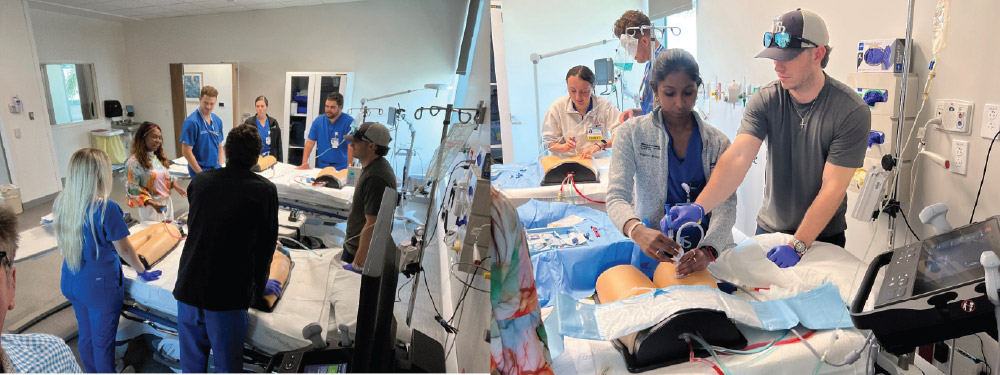PGY1
- Orientation- 1 month
- OB/GYN- 1 month
- MICU- 1 month
- POCUS/Anesthesia- 1 month
- Trauma- 1 month
- Pediatric EM- 1 month
- Selective- 1 month
- Emergency Medicine- 5 months
Residents will have dedicated time for academic conferences every Wednesday morning. These sessions include didactics, case presentations, hands on workshops, and journal club. The residents do not work in the ED after 10pm the night before didactics to help protect this important time for learning. As per ACGME and FSU GME requirements, residents will perform a Quality Improvement (QI) project and participate in scholarly activity. Our academic calendar is based on the calendar month with each rotation starting on the 1st and finishing on the last day of the month so there are 12 rotations per year. Our interns start with a 1-month orientation that includes didactics, hand on workshops, certification courses, short shifts with our nurses and pharmacist, and a few shifts in the ED. This month is an excellent opportunity for our residents to get comfortable and feel prepared to begin their training. They also get a chance to bond as a class with multiple wellness events and opportunities to socialize. The only off campus rotation is the pediatric ICU month which the residents complete at the Johns Hopkins All Children’s Hospital. This site is about an hour away in beautiful St. Petersburg, Florida and housing is provided for the month to minimize the need to commute.
Hours are based on a calendar month (not a 28-day cycle). Shift length ranges from 8-11 hours. Interns do not work overnight shifts. Residents typically have at least two full weekends off per month.
We send each class of residents to a conference annually with registration, travel, hotel fees and a food allowance provided. Currently our interns go to FCEP, our second years go to SAEM, and our third years go to ACEP. Further conference opportunities exist if our residents are presenting.
The Model of the Clinical Practice of Emergency Medicine (EM Model) serves as the basis for our curriculum. It is our goal that our residents master this material, are more than prepared to practice in any environment and perform well on the emergency medicine certifying examination.


Simulation is an important part of the training provided in our residency curriculum. Residents will participate in regularly scheduled simulation days throughout the academic year in our new state-of-the-art simulation lab. The lab is located in the newly built Kolschowsky Research and Education Institute which includes 84,000 sq ft of sim/research/meeting space with dedicated classrooms, control rooms, and sim rooms. The simulation curriculum will be led by our experienced faculty team including three co-directors, designated sim chief residents, and sim techs. These experiences will include hands-on procedures on state-of-the-art mannequins, communication and teamwork training. Residents will also have opportunities to design and develop cases, engage with different learners, and become efficient with feedback and assessment.
Graduates will gain confidence to perform any procedure that presents itself during the day to day practice of Emergency Medicine. There will be extensive repetition of the common day to day procedures like intubation, lumbar puncture, and central lines both in the clinical setting and in the simulation lab.. Other HALO (high acuity low occurrence) procedures such as pericardiocentesis, transvenous pacemaker insertion, cricothyroidotomy, and more are covered in our simulation lab. With this training the graduating physician will be able to perform these HALO procedures in the rare occurrence it is necessary in their clinical practice. The simulation team and the residency program as a whole are committed to ensuring our residents are prepared for clinical practice and for their certifying exams.
Sheila Bagley
Program Coordinator
Sheila.Bagley@med.fsu.edu
Phone: 941-917-2041
1700 South Tamiami Trail
Sarasota, Florida 34239